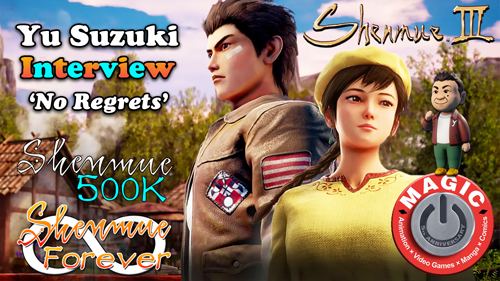
As fans count down the months, days, hours and minutes till the release of Shenmue 3, Yu Suzuki is normally found in his Tokyo development studio at Ys Net, where his “impossible sequel” is being polished and prepped for launch on August 27th.
But earlier this month he was almost a world away, surrounded by sports cars and casinos on the French Riviera. While the sun beat down on the winding, sloping streets of Monaco however, Suzuki would be on stage in a conference hall, discussing the game before rows of nostalgic fans, and revealing a new trailer so reassuring that it drew tears in the tiers.
In between these keynote appearances, Suzuki’s schedule at MAGIC 2019 would be packed with two hour-long autograph sessions and a number of behind-closed-doors previews with members of the press. Squeezing in a bunch of interviews with the online fan community would have to wait for the next event on the marketing calendar.
If this were any star guest but Yu Suzuki.
Instead, our representatives were invited to his hotel the previous day, and the legendary game designer gave up his afternoon to talk shop, through an interpreter, with people who’d grown up playing Out Run, Space Harrier, Virtua Fighter, and the series that brought them all together.
Firat of Shenmue 500K and Cosman of Shenmue Forever chatted with Yu-san about a range of topics, and as always when 500K’s involved, some of these came from members of Facebook’s largest Shenmue group.
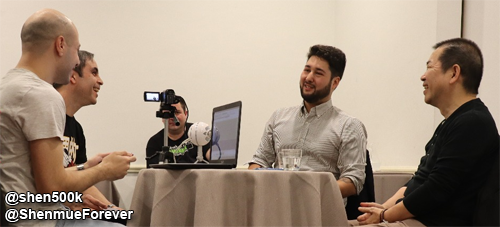
Having so many fans active on social media creates a slightly different landscape than the late 1990s, when development of the original Shenmue titles was in full swing. There were a handful of dedicated messageboards of course, but feedback is far more widespread and constant these days. We wondered how the daily babble, often contradictory within itself, affected Suzuki and his team, but he explained that it’s not something he’s exposed to on such an ongoing basis.
“Basically, I only reach out for information when I want it,” he said, “So I’m not really influenced by it. My approach is to fetch information when I need it.”
Not all aspects of online culture can be selectively managed, however:
“From another perspective, compared to the past, networks and information flow much more easily. For example, things like strategy guides become available in an instant. The same goes for information about bugs and so on. All sorts of information spreads really quickly. Consequently, these days the need for paper-based strategy books like in the past is disappearing. However, this rapid spread of information may take away the enjoyment of solving things yourself. This is something I’ve thought about: such as whether there’s a way to ensure an enjoyable experience, even under these circumstances. I keep things like this in mind.”
So with written and video walkthroughs just a click away for today’s gamers, the director of Shenmue 3 considers it important to account for this when designing the experience, so that the game remains fun even if players give in to temptation and follow a guide.
It’s also interesting that he’s mindful of bug information so rapidly becoming public knowledge. Five months from release, we know that the remaining time is being spent polishing the game – perhaps to ensure that any glitches, once the reserve of highly attentive fans and their immediate circle of friends, don’t become the next meme lighting up Twitter and Facebook at Ys Net’s expense.
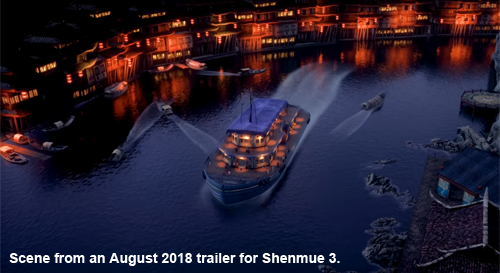
One matter that remains the exclusive topic of hardcore fans, albeit persistently, is the “boat chapter” that was cut from the beginning of Shenmue 2. In this part of the story, later recapped in the form of an unlockable comic strip in the Xbox version and recent PC, PlayStation 4 and Xbox One re-releases, protagonist Ryo was due to re-encounter the resilient reprobate Chai, rescuing a young girl in the process. Time constraints however called for this playable sequence, set aboard the ship from Yokosuka to Hong Kong, to be removed.
But recent comments made in China suggest that content from these scenes will somehow feature in Shenmue 3. One line of speculation had involved revisiting this specific voyage in a flashback. Will that be the case?
“No, it won’t,” confirmed Yu-san, “There will be different flashbacks, though.”
What remains, then, is the theory that ideas once intended for that trip to Hong Kong will perhaps be repurposed for a different journey in the story, with a passenger boat already seen in quite some detail in pre-release materials for Shenmue 3.
Not everything about the previous games will be transplanted into the new sequel though, as we learned while discussing Ryo’s relationship with Bailu Village once he settles in, and whether it might compare with the friendly atmosphere of his neighborhood in Shenmue I.
“Hmm… I don’t think it will have a similar feeling,” Suzuki told us, “In the same way that 1 and 2 feel different from each other, there will also be a different feeling between 2 and 3. So I think it probably won’t evoke quite the same kind of feeling.”
He went on to compare Ryo’s interactions with other characters in each game, “There may not be as many changes occurring rapidly just from talking a lot with people. However there is quite a large amount of dialogue, so doing so may help to gain a better sense of people’s personalities.”
It seems the player will therefore get to know the villagers much more deeply than the residents of Dobuita, without bouncing from one to the next as soon as Ryo has a new lead to pursue.
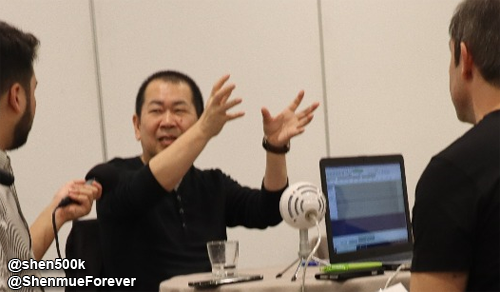
But this is still Shenmue, and there will inevitably come a time when the talking stops and the fists must fly. Sometimes you just have to punch a dude in the mouth, and we enquired as to whether Ryo would begin Shenmue III with the same martial arts moves that we’d become familiar with in the previous entries.
“We’ve made it basically like that,” said Suzuki, perhaps in allusion to what would soon be learned about fights in this game not incorporating a throw mechanic.
In any game there are, of course, always things the developer would like to include but for one reason or another cannot. The same was true of Shenmue 1 and 2. We asked what he’d been able to work into Shenmue 3 that hadn’t been possible in the original games on Dreamcast.
“Well the hardware wasn’t really a big factor,” he explained, “Shenmue is a concept, a way of thinking, so I’ve put into Shenmue 3 some of the things that I couldn’t fit, or couldn’t do, in Shenmue 1 and 2.”
As an example: “One thing that I had wanted to do in Shenmue 1 and 2, but wasn’t able to fully realize, was to achieve a good balance in the economy. And another was to do with the user cycle: ensuring that the cycle is properly balanced.”
The games, after all, provide the player with a broad range of tasks and options, from shifting crates and pallets, to playing darts and Hang-On, to buying and selling capsule toys; immersing fans who feel this variety enhances world building, but sometimes leaving newcomers feeling unfocused, and unmotivated to explore beyond the core narrative.
“Shenmue is made up of many different elements, but in Shenmue 1 and 2 the way each of them connects with others was quite weak,” Yu admitted, “In Shenmue 3, there’s a strong link between each of the parts. So I’d like players to enjoy playing with these in Shenmue 3, once it’s released. That’s probably the biggest difference, compared with Shenmue 1 and 2.”
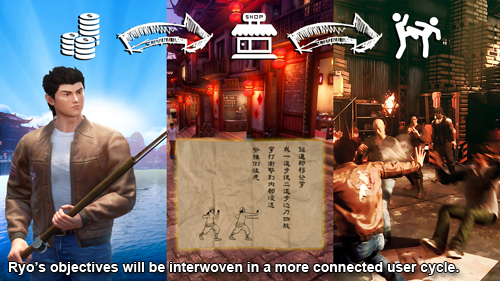
According to this philosophy then, players who might have found the original games disjointed experiences are now likely to enjoy the smoother, more connected design of Shenmue 3, aimed at better engaging the player with every activity the sequel has to offer, closely aligning them all with the context of Ryo’s quest.
But if that’s what he’s learned from the first two games, what’s Suzuki’s big takeaway from developing Shenmue 3? It may be too soon to dissect the entire process, but on reflection, we asked if there was one piece of advice he’d like to have received at the beginning of this project.
Mulling it over, the director at first replied, “Hm… The thing is, back then I did everything I could, really. So I don’t really have any regrets.”
But a flash of inspiration soon occurred: “Oh, I just remembered one thing, though. When the Kickstarter had just begun, there was a flood of people trying to access it, causing the server to crash. So if I had the chance to do it again, I’d make the servers more robust, and perhaps an even higher record might be reached!”
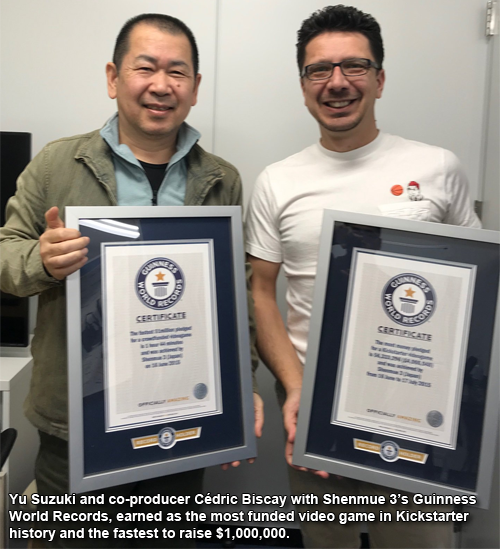
Never change, Yu Suzuki. Never change.
Shenmue 3 releases August 27th on PC and PlayStation 4, with preorders available now. Help spread the word every 3rd with the monthly Shenmue Tweetathon!
We’d like to thank Yu-san along with everyone who made this interview possible, including his interpreter Kenji, Cédric Biscay and Shibuya Productions, Deep Silver, Trent and Shendream at Shenmue Master, all the Facebook group members who inspired topics of discussion, and the community’s own hardworking translator, Switch at Phantom River Stone.
